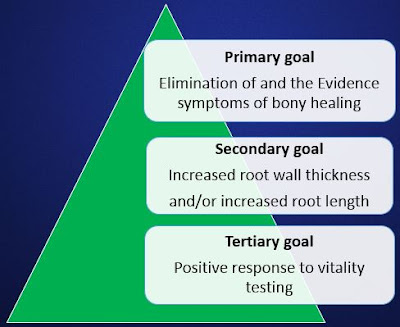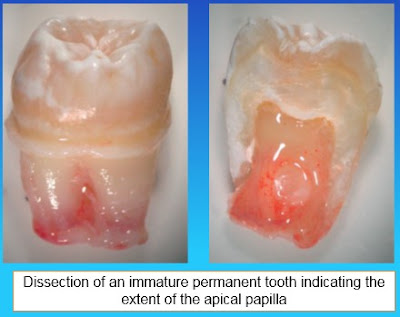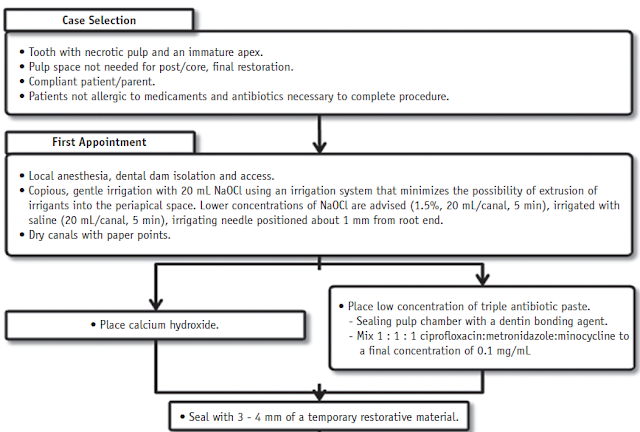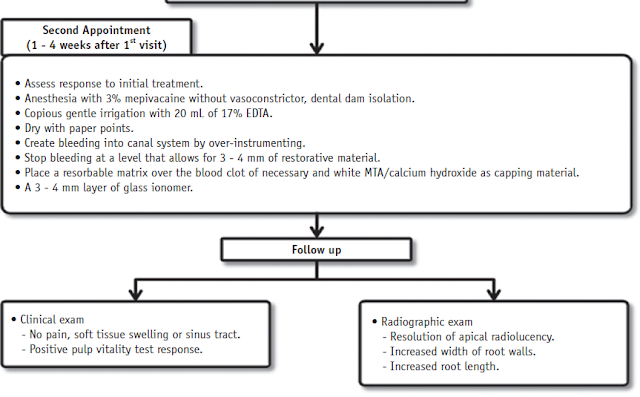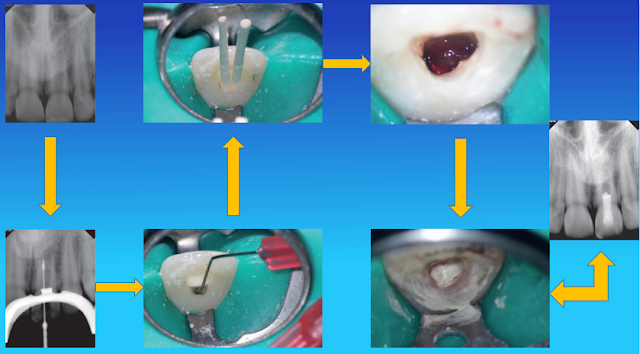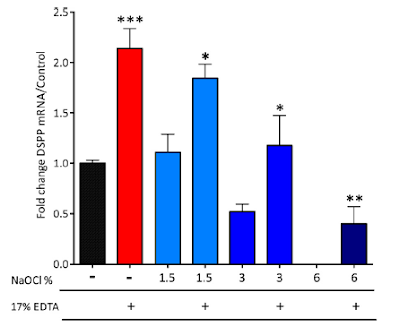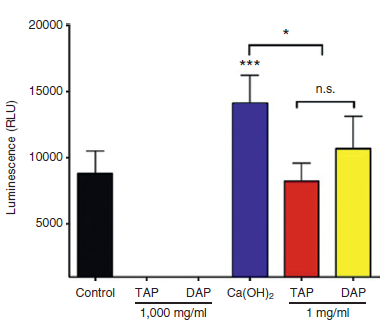Regeneration in Endodontics
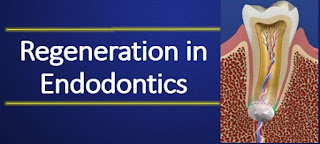 |
| Regeneration in Endodontics |
Current endodontic therapy aims to maintain the health of
the pulp in cases of inflammation, but a much-desired objective is (Regeneration
in Endodontics) the regeneration of a healthy pulp–dentin complex.
Traditionally, apexification has been used to treat immature
permanent teeth that have lost pulp vitality. This technique promotes the
formation of an apical barrier to close the open apex so that the filling
materials can be confined to the root canal.
On the contrary, regeneration in endodontics showed normal
maturation of root in the radiograph.
Because tissue regeneration cannot be achieved with
apexification, a new technique called regenerative endodontic treatment was
presented recently to treat immature permanent teeth.
Regenerative endodontic treatment is a treatment procedure
designed to replace damaged pulp tissue with viable tissue which restores the
normal function of the pulpdentin structure.
DEFINITIONS
Regenerative
endodontics are biologically based procedures designed to replace damaged
structures, including dentin and root structures, as well as cells of the
pulp–dentin complex.
Revascularization,
as defined by Andreasen, is the restoration of the vascularity to a tissue or
organ
Repair is the
restoration of tissue continuity without the loss of original architecture and
function.
Revitalization is
described as an in-growth of vital tissue that does not resemble the original
lost tissue.
HISTORY
Nygaard–Ostby, 1961: Use of a revascularization procedure for regeneration of the
pulp–dentin complex in immature teeth with pulpal necrosis.
Rule DC, 1966: Use of double antibiotic paste
Hoshino, 1993: Use
of triple antibiotic paste
Iwaya, 2001: Evoked intracanal bleeding step
Banchs and Trope, 2004: Case reports on immature mandibular
premolars
GOALS OF REGENERATION IN ENDODONTICS
COMPONENTS OF REGENERATIVE ENDODONTICS
1. Stem Cells
2. Growth Factors
3. Scaffold
1. Stem Cells
According to Diogenes
et al., regenerative endodontic procedures are stem cell–based therapies.
These are undifferentiated cells that are capable of
differentiating into various specialized cell types.
They can be pluripotent or multipotent in nature.
Types of Stem Cells
According
to Hargreaves, the first five stem cells listed in Box are the most commonly employed stem cells in
regenerative endodontics.
Comparison between stem cells from the apical papilla (SCAP) and dental pulp stem cells (DPSCs)
2. Growth Factors
Biological factors regulate stem cells to form the desirable
cell type. There are five major families of growth factors, of which bone
morphogenetic proteins (BMPs) are significant for tooth regeneration.
3. Scaffold
Scaffold is a three-dimensional structure that contains
growth factors. It has the following functions:
Supports cell organization and vascularization
Aids stem cell proliferation and differentiation
Leads to improved and faster tissue development
Contains nutrients to promote cell survival and growth
May contain antibiotics to prevent bacterial ingrowth in the
canal systems
Mechanical and biological functions
Classification of Scaffold
Scaffolds can be classified as natural and synthetic.
Natural: Collagen, platelet-rich plasma, fibrin, and
glycosaminoglycans
Synthetic: Polylactic acid, polyglycolic acid (PGA), and
poly(lactic-co-glycolic) acid (PLGA)
MECHANISM OF REVASCULARIZATION
According to Shah N, the possible mechanisms by which the
process of revascularization takes place are as follows.
1. A few vital pulp cells remaining at the apical end of the
root canal might proliferate into the newly formed matrix and differentiate
into odontoblasts. This may happen under the influence of the cells of
Hertwig’s epithelial root sheath, which are quite resistant to destruction,
even in the presence of inflammation.
2. Continued root development could be due to multipotent
dental pulp stem cells, which are present abundantly in immature permanent
teeth.
3. Stem cells in the periodontal ligament can proliferate
and grow into the apical end and within the root canal. They may deposit hard
tissue both at the apical end and on the lateral root walls.
4. The fourth possible mechanism of root development could
be attributed to SCAP or to the bone marrow.
THE CHARACTERISTICS OF THREE TREATMENT PROCEDURES FOR IMMATURE ROOT FORMATION
THE PERCENTAGE INCREASE IN ROOT WIDTH AND ROOT LENGTH AFTER THE TREATMENT PROCEDURE
The following represents an initial framework to identify major research priorities in developing regenerative endodontic techniques
ROOT CANAL REGENERATION PROCEDURE
Since many types of regenerative endodontic treatment
procedures have been suggested, it is important to have knowledge of the
procedure that is generally used. Current regimen of regenerative endodontic
treatment procedures by AAE.
Indications
Teeth with necrotic pulp and an immature apex
Pulp space not needed for post/core, final restoration
Patient compliance
No allergy to the medicaments to be used
The triple antibiotic paste is the most commonly advocated
type and the following guidelines have to be ensured when employing an
antibiotic paste:
It remains below CEJ (minimize crown staining).
Concentration is adjusted to 0.1 mg/mL (100 μg of each
drug/mL).
The pulp chamber is sealed with a dentinbonding agent to
avoid the risk of staining.
A final rinse with 17% ethylenediaminetetraacetic acid
(EDTA) is recommended during irrigation as it is found to promote the
bioavailability of growth factors such as transforming growth factor-beta
(TGF-β) and dentin sialoprotein (DSP) in the dentin matrix. These stimulates
stem cell proliferation and differentiation.
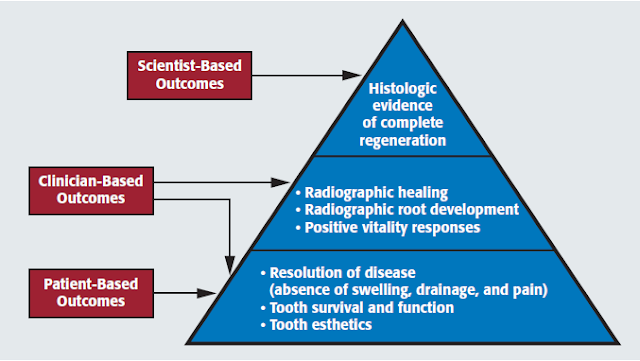 |
| Trilevel outcome assessment pyramid |
Concentration-dependent Effect of Sodium Hypochlorite on Stem Cells of Apical (Martin et al.)
Study on DSPP Cells
Standardized root canals were created in extracted human
teeth and irrigated with NaOCl (0.5%, 1.5%,3%, or6%) followed by 17%EDTA or
sterile saline.
Martin et al found that NaOCl at the concentration of 1.5%
had no effect on DSPP gene expression compared with the control group, whereas
the 3% concentration reduced DSPP gene expression by approximately 50%.
Importantly, dentin conditioning with 6% NaOCl completely abolished DSPP
expression.
Furthermore, the addition of a final irrigation with 17%
EDTA increased DSPP expression after 1.5% NaOCl compared with control. A final
irrigation with 17% EDTA reversed the deleterious effects of dentin
conditioning with 3% and 6% NaOCl, complete and partial reversal, respectively.
Study on Scap Cells
The concentrations of 0.5%, 1.5%, and 3% all evoked a
similar reduction of approximately 37% in SCAP survival, whereas treatment with
6% NaOCl resulted in greatly diminished SCAP survival.
The addition of a final irrigation with 17% EDTA reversed
the negative effects of NaOCl on SCAP survival, resulting in survival
comparable with controls (no treatment) but still lower than the survival
positive control.
Concentration dependent effect of Intracanal Medicament on SCAP Cells
SCAP culture on dentin treated with TAP or DAP at the
concentration of 1000 mg/mL resulted in no viable cells. Conversely, dentin
conditioning with TAP or DAP at the concentration of 1 mg/mL supported cell
viability with no difference from untreated dentin disks (control). Greater
survival and proliferation were detected in the group treated with Ca(OH)2.
Factors that affect the results of regenerative endodontic treatment
A comparison between the single visit and multiple visit regenerative endodontic treatment procedures
Medicament used in regenerative endodontic treatment
In 1996, Hoshino et al. recommended a tri-antibiotic
paste, which was composed of ciprofloxacin, metronidazole, and minocycline, to
disinfect the canal, and this medicament can be used effectively in
regenerative endodontic treatment.
Chueh et al. reported that complete disinfection of
the canal and regeneration can be achieved by using calcium hydroxide alone
Regenerative endodontic treatment with the
1) triple antibiotic paste
2) calcium hydroxide
3) formocresol
produced significantly greater increases in root
length and width compared with that in the control group. There were no
significant differences in root length among the three groups of medicaments.
In terms of changes in root width, the triple
antibiotic paste produced significantly greater increases in dentin wall
thickness compared with the other two medicament groups
Advantages of Regeneration
Achieving continued root development (root lengthening)
and strengthening due to reinforcement of lateral dentinal walls with
deposition of new dentin/hard tissue are the biggest advantages.
Obturation of the canal is not required unlike in
calcium hydroxide–induced apexification (inherent danger of splitting the root
during lateral condensation can be avoided).
After control of infection, the procedure can be completed
in a single visit.
Disadvantages
Discoloration due to use of minocycline in triple antibiotic
paste (revealed by Kim et al.)
Prolonged treatment period and more appointments
(compared with one-visit MTA apical barrier technique)
POTENTIAL CAUSES OF FAILURE
Poor root development (absence of increase in root
length, absence of increase in root wall thickness, or lack of formation of
tooth apex)
Insufficient bleeding during the procedure
Root canal calcification/obliteration.
Conclusion
Regenerative endodontics holds promise of restoring pulp–dentin
complex in teeth with immature roots and necrotic pulps. This procedure has potential
advantages versus traditional treatment procedures of increasing root wall
thickness and root length while maintaining immune competency. Still,
significant scientific hurdles need to be overcome with continued growth in
knowledge and armamentarium.
